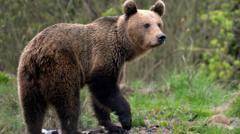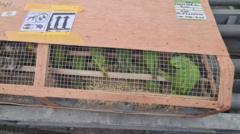The recent death of a motorcyclist due to a bear attack raises concerns about wildlife management and public safety in Romania.
A Fatal Encounter: Bear Kills Motorcyclist in Romanian Mountains

A Fatal Encounter: Bear Kills Motorcyclist in Romanian Mountains
A tragic bear attack in the Romanian mountains underscores the risks of human-wildlife interactions.
In a tragic incident that has alarmed both locals and tourists, a man was killed after being attacked by a bear while riding his motorcycle in Romania's picturesque Transfagarasan mountain region. Authorities reported that the incident happened on Tuesday morning when the victim, having parked his motorcycle near a tourist hotspot, was dragged approximately 80 meters down a steep ravine by the bear. Ion Sanduloiu, head of the Arges County Mountain Rescue Service, indicated that the man was unfortunately deceased upon arrival of the rescue team, despite wearing protective gear.
Sanduloiu highlighted the importance of adhering to safety guidelines, including avoiding stops in bear-populated areas and refraining from feeding the animals. Initial reports suggest that the bear involved has not yet been euthanized, as investigations into the fatal encounter continue. Romania boasts the largest brown bear population in the EU, but with this comes increased human-bear interactions, raising alarms about potential dangers.
Recent estimates by the Romanian environment ministry suggest a brown bear population between 10,400 and 12,800 bears—significantly above the sustainable level of 4,000 set by former environment minister Mircea Fechet. This overpopulation raises concerns and has led to discussions on implementing revised regulations to manage bear populations effectively and ensure public safety.
Conservationists, such as Gabriel Paun from the NGO Agent Green, argue that the issue at hand primarily stems from mismanagement rather than bear overpopulation itself. Paun criticized the local and national authorities for not adequately addressing the risks of tourists interacting with wildlife, as well as failing to execute proper wildlife management plans. He emphasized that issues such as habitat destruction and trophy hunting also pose significant threats to bear populations in Romania.
Calling for action, Sanduloiu suggested that stronger deterrents, including increased fines and prison sentences for feeding bears, could help prevent future tragedies. As the investigation continues, this incident sheds light on the complex dynamics between human activities and wildlife conservation in Romania.
Sanduloiu highlighted the importance of adhering to safety guidelines, including avoiding stops in bear-populated areas and refraining from feeding the animals. Initial reports suggest that the bear involved has not yet been euthanized, as investigations into the fatal encounter continue. Romania boasts the largest brown bear population in the EU, but with this comes increased human-bear interactions, raising alarms about potential dangers.
Recent estimates by the Romanian environment ministry suggest a brown bear population between 10,400 and 12,800 bears—significantly above the sustainable level of 4,000 set by former environment minister Mircea Fechet. This overpopulation raises concerns and has led to discussions on implementing revised regulations to manage bear populations effectively and ensure public safety.
Conservationists, such as Gabriel Paun from the NGO Agent Green, argue that the issue at hand primarily stems from mismanagement rather than bear overpopulation itself. Paun criticized the local and national authorities for not adequately addressing the risks of tourists interacting with wildlife, as well as failing to execute proper wildlife management plans. He emphasized that issues such as habitat destruction and trophy hunting also pose significant threats to bear populations in Romania.
Calling for action, Sanduloiu suggested that stronger deterrents, including increased fines and prison sentences for feeding bears, could help prevent future tragedies. As the investigation continues, this incident sheds light on the complex dynamics between human activities and wildlife conservation in Romania.




















